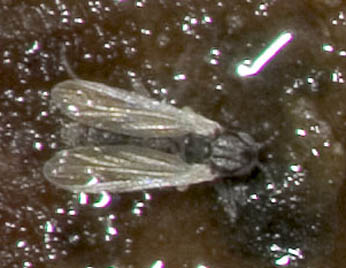Diptera.info :: Identification queries :: Diptera (adults)
|
Gnat or Midge at Sap
|
|
| Stephen |
Posted on 21-09-2006 12:05
|
|
Member Location: West Virginia USA Posts: 1322 Joined: 12.04.05 |
On a recently-cut tree stump there was a lot of moisture, and several species of fly were feeding. One was this little fellow, which measured 1.5 mm from the front of the face to the rear of the wings. The wings were longer than the abdomen. 6 April 2006, West Virginia, USA. Any ID help would be appreciated! Stephen attached the following image:  [46.79Kb] --Stephen Stephen Cresswell www.americaninsects.net |
| Tony Irwin |
Posted on 21-09-2006 20:10
|
|
Member Location: Norwich, England Posts: 7318 Joined: 19.11.04 |
Difficult to be certain, but this looks like Ceratopogonidae to me.
Tony ---------- Tony Irwin |
|
|
|
| Jan Willem |
Posted on 22-09-2006 07:06
|
|
Member Location: Waalwijk, The Netherlands Posts: 2160 Joined: 24.07.04 |
I would go for Chironomidae. Jan Willem |
|
|
|
| Stephen |
Posted on 22-09-2006 10:01
|
|
Member Location: West Virginia USA Posts: 1322 Joined: 12.04.05 |
I should have walked the 2 km back to the fly with my stronger lens! Wish we could see more details here. A more contrasty background would help us see the antennae better too.
--Stephen Stephen Cresswell www.americaninsects.net |
| Jan Willem |
Posted on 22-09-2006 12:19
|
|
Member Location: Waalwijk, The Netherlands Posts: 2160 Joined: 24.07.04 |
The reason I would go for Chironomidae instead of Ceratopogonidae is the wing venation. |
|
|
|
| Tony Irwin |
Posted on 22-09-2006 20:00
|
|
Member Location: Norwich, England Posts: 7318 Joined: 19.11.04 |
The wing venation of Ceratopogonidae and Chironomidae is very similar - the major diffference is that vein M is usually forked in Ceratopogonidae and not obviously forked in Chironomidae. I really cannot tell from Stephen's photo which it is!  The other factor is that Chironomidae are very rarely observed feeding, but that's not to say that Stephen hasn't photographed a rare event!  Tony ---------- Tony Irwin |
|
|
|
| Jan Willem |
Posted on 23-09-2006 11:07
|
|
Member Location: Waalwijk, The Netherlands Posts: 2160 Joined: 24.07.04 |
Well, in the Ceratopogonidae the R-veins are in most cases clearly shortened, which is not the case in Chironomidae. In the specimen of Stephen it looks like the R-veins are not shortened, but I have to admit that it is difficult to be sure from the picture. Jan Willem |
|
|
|
| Tony Irwin |
Posted on 23-09-2006 20:25
|
|
Member Location: Norwich, England Posts: 7318 Joined: 19.11.04 |
It's true that many Ceratopogonidae have shortened radial veins, but there a number of genera which have R-veins as long as those of Chironomidae (and the occasional chironomid with shortened R). So I think Stephen will have to revisit the site next April and catch one of these beasts! 
Tony ---------- Tony Irwin |
|
|
|
| Stephen |
Posted on 23-09-2006 22:02
|
|
Member Location: West Virginia USA Posts: 1322 Joined: 12.04.05 |
It does sound like this photo is just to small to do much with. I will indeed revisit the area this Spring looking for similar fresh stumps and the flies that visit them.
--Stephen Stephen Cresswell www.americaninsects.net |
| Jump to Forum: |













